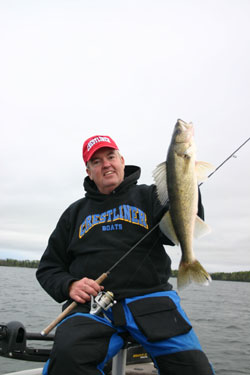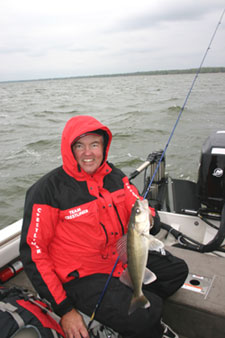 In between trips to North Dakota for ducks, South Dakota and SW Minnesota for pheasants, and northern Minnesota for grouse, there’s some really good walleye fishing to be had. The tough part is giving up one for the other and has been made even more difficult with pheasant numbers up and grouse up in certain areas. Even so; you might find the tradeoff to be worthwhile, especially when you start hooking up with chunky late season ‘eyes.
In between trips to North Dakota for ducks, South Dakota and SW Minnesota for pheasants, and northern Minnesota for grouse, there’s some really good walleye fishing to be had. The tough part is giving up one for the other and has been made even more difficult with pheasant numbers up and grouse up in certain areas. Even so; you might find the tradeoff to be worthwhile, especially when you start hooking up with chunky late season ‘eyes.
The big attraction to late season walleye angling is its implicity, and is a time when a fish that can be exceedingly complicated becomes easy to read and easy to catch. The key is really knowing where to look and includes deep breaks and hard bottom areas. Hard bottom is a relative thing though and might include a rock or gravel bottom, or even a hard sand break, and will depend on what’s available. When you’re looking for a good place to start you can figure that sand is good, sand and gravel is better, and gravel and rock can be even better. A quick break with hard bottom is a classic spot but don’t overlook hard bottom shelves or flats which can also hold plenty of late season walleyes. A nice hard bottom flat at the base of a quick break deserves some attention, and so does a shelve that extends beyond the base of a deep weed line. A deep flat with a slight bump or rise out in the middle of nowhere is another potential hot spot that could be easily overlooked by other anglers. A hard bottom break is a good place to start looking but definitely not the only area that can hold fish.
The best thing about it all is that you can do your looking with a graph as walleyes are easily marked when they’re holding over harder bottom. With a high definition graph like the Humminbird 997c you scan deeper areas and have a real good idea if you’re in the right area. A run up and down a break and over and back again across a hump will quickly reveal the presence of fish. They might be holding tight to as much as a foot or two off the bottom, and you better be marking if you plan on catching. Fish that don’t mark probably aren’t there and you better keep moving until you find some sign of life. You can also read the hardness of the bottom by the thickness of the red bottom reading. Red means more density and the thicker the red line the harder the bottom.
 Once you’ve found a likely looking area it’s time to try catching and is easy as dropping down a jig and minnow and slowly working it along the bottom. A heavier jig like a 3/8oz Northland Rattlin’ Fire-ball tipped with a small to medium sized shiner is perfect for working deeper structure. A heavier jig will make it easier to work it straight up and down and will give you more feel and even let you determine if you’re over hard or soft bottom. Even though the lightest jig you can get away with is usually preferred; heavy will help you stay with the bottom and even make more noise which can be a real trigger for nailing fall walleyes.
Once you’ve found a likely looking area it’s time to try catching and is easy as dropping down a jig and minnow and slowly working it along the bottom. A heavier jig like a 3/8oz Northland Rattlin’ Fire-ball tipped with a small to medium sized shiner is perfect for working deeper structure. A heavier jig will make it easier to work it straight up and down and will give you more feel and even let you determine if you’re over hard or soft bottom. Even though the lightest jig you can get away with is usually preferred; heavy will help you stay with the bottom and even make more noise which can be a real trigger for nailing fall walleyes.
When you lift and drop the jig you can actually feel the bottom if you’re paying attention, and a lift and drop is about all the action you’ll need to trigger active walleyes. The lift gets the rattles going and so does the thump when it drops and bangs back into the bottom. The key is to stay with the jig and not let the line go slack, just hit the bottom and then hold and feel, and then lift and drop again. If you’re marking fish try working the jig straight up and down and right through the middle of them and go back over and over again and see if you can get a response.
With the right gear you can actually feel it all and is when a medium action spinning combo like St. Croix’s 6’3” Vertical Jig rod can really make a difference. The Vertical Jig rod was designed for this very purpose and has the right action to produce a snap on the lift and yet provide incredible feel, and feel is what it’s all about. A braided line like Berkley Fireline can also help with the “feel factor” but be sure to tie in a three foot leader like eight pound test Vanish. Walleyes can be incredibly fussy and a leader that’s virtually invisible can make a big difference. Being able to feel the bottom and feel the bite will mean more fish boated and more fish in the boat and will mean a lot more fun. That’s as simple as it gets. See you on the water.










